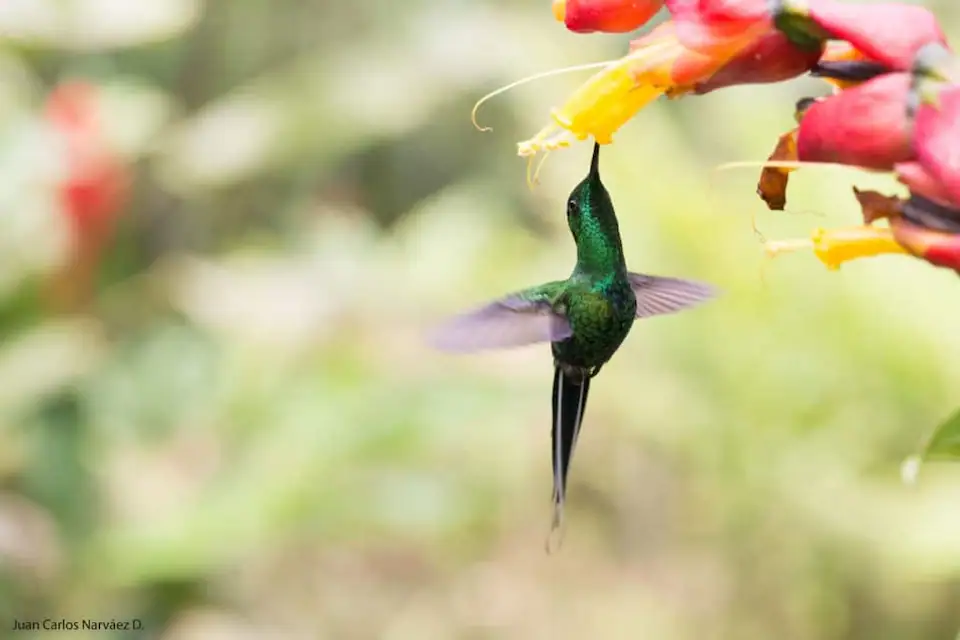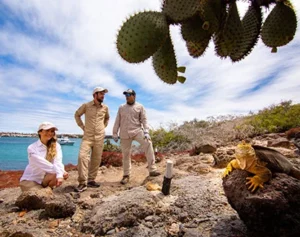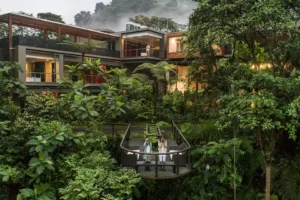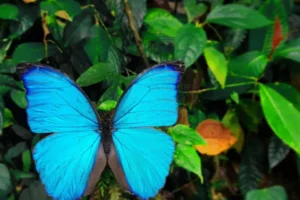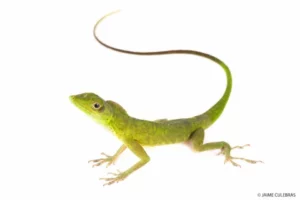The Mashpi Reserve is located in a stunning natural setting northwest of Quito, Ecuador. It is a true home to colorful hummingbirds, one of the most fascinating species in the animal world. These species of hummingbirds inhabit almost the entire American continent, and the estimated lifespan of a hummingbird is 3 to 4 years. Researchers estimate that about 300 species live in Ecuador, and more than half live there.
These birds are known for their flight speed, beating their wings between 50 and 80 times per second. In addition, they are evolutionary engineers who are perfectly equipped to play a crucial role as pollinators. Because they are a very active species, hummingbirds feed on and require a large amount of floral nectar and supplement their diet with small insects. But the most striking thing about this species is their iridescent plumage that shimmers like rainbows. Hummingbirds are undoubtedly among our planet’s most vibrant and visually stunning birds.
Get ready to explore the exciting world of these fantastic, winged creatures. Hummingbirds will amaze you with their brilliant plumage and cunning nest-building skills, nature’s incredible creativity, and the unique adaptations that have evolved in these genuinely remarkable species.
The Magic of the Hummingbirds
White Whiskered Hermit (Ermitano Bigotiblanco)
The White-whiskeres hermit (Phaethornis yaruqui) of the Trochilidae family is a bird species in Colombia, Ecuador, and Panama. This bird usually lives in the lower part of the rainforest.
It measures about 13 cm and has a curved bill of 6 mm. Its mandible is red, a characteristic detail of the bird.
Its crown has a bronze coppery tone with a dark spot behind each eye and a white-to-yellowish line on the edge. The plumage of the back is metallic green, while the plumage of the underparts is grayish green and has a white line between the throat and breast, and finally, it has a bluish-black tail with a white tip.
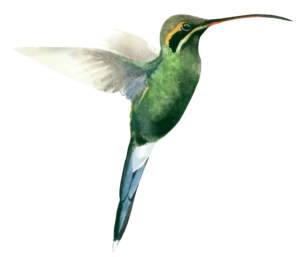
Purple-bibbed Whitetip (Puntiblanca Pechipurpura)
The Purple-bibbed Whitetip (Urosticte benjamini) of the Trochilidae family is a bird species in the Trochilidae family. It is found in the humid zones of the biogeographic Chocó, in Colombia and Ecuador.
This bird can measure between 7 and 9 cm in length; its beak is straight and reaches 18 mm in length. Its plumage color is metallic green or turquoise blue, with a white spot behind the eye and a characteristic fuchsia crescent-shaped patch on the upper part of the breast, bordered by a narrow white line below. The tail is short and black, with a pair of central feathers with white and red tips visible above.
It feeds on various flowers from the understory to the canopy and regularly visits them at feeders.
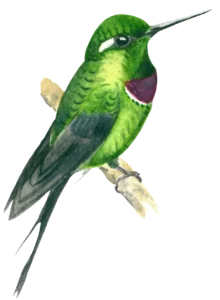
Booted Racket- Tail (Colibri cola de raqueta)
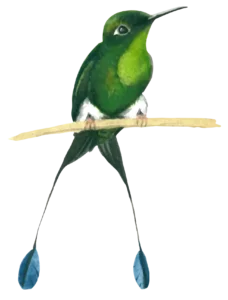
The Booted Racket-Tail (Ocreatus underwoodii) of the family Trochilidae is a species of bird of the family Trochilidae that lives in Bolivia, Colombia, Ecuador, Peru, and Venezuela. It lives in humid forests, including cultivated fields and gardens.
This bird averages 12.7 cm in length, with a 7.6 cm tail and a 13 mm bill. The plumage is generally bright metallic green, but the throat is the most colorful. The male’s tail is impressive, with two long, curved outer feathers ending in greenish-blue rackets. Generally, this species feeds on insects in flight and feeds on nectar from various flowers.
Green Thorntail (Colicerda Verde)
The Green Thorntail (Discosura conversii) of the Trochilidae family is a tiny hummingbird that inhabits all regions of Costa Rica, Colombia, and Ecuador. They usually stay high in the canopy, although found in various woodland and garden habitats.
The male is 10 centimeters long, with green underparts and a long thread-like tail that gives it its name. The Green-rumped Tufted Tit (male) is characterized primarily by its green back, a white line on the torso and lower torso, as well as its elongated, black tail.
Unlike the female, which is 7.5 centimeters long, it does not have a long tail and has a blackish belly with a green band on the chest. Instead, it has striking white whiskers.
These birds visit small flowers, including epiphytes and shrubs, and capture small flies and wasps.
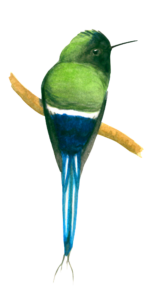
Purple-throated Woodstar (Estrellida Gorjipurpura)
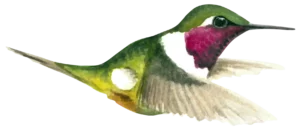
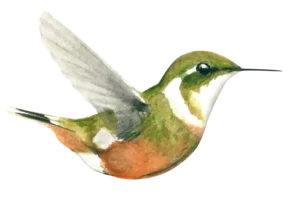
Purple-throated Woodstar (Philodice mitchellii) is a hummingbird belonging to the tribe Mellisugini and the Trochilidae family. They inhabit Colombia, Ecuador, and Panama. These species live on the edges and in the interior of humid and mesophilic forests. This species measures 6.8 to 7.5 cm; this depends on the bird’s sex.
Among its characteristics, the males have a bright purple throat, a white band on the breast, a relatively long forked tail, and white spots on the sides of the rump.
The difference between the male and female makes it more difficult to distinguish. Their features are that they have no purple at all, only an orange belly with a bit of white in the center and a thin white line extending behind the eye and around it, plus their tail is very short.
It is often seen feeding alone in the canopy or visiting feeders.
Brown Violetear (Orejivioleta Parda)
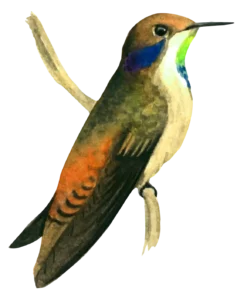
The Trochilidae’s Brown Violetear (Colibri delphinae) is a hummingbird species in high forests. It can be found from southern Guatemala to Bolivia, Ecuador, and western Brazil and generally lives high in the rainforest canopy or coffee plantations.
This bird is particularly distinctive for its dull brown color, with reddish clusters and grayer underparts. Behind the eye is a violet spot, and on the throat is a bright green and blue malar stripe, which makes it particular. Its length can reach 11.5 cm.
The nectar of the tiny flowers of trees, shrubs, and epiphytes serves food for the brown violets. In addition, it consumes insects that are often captured in flight.
Green Crowned Woodnymph (Ninfa Coroniverde)
The Green Crowned Woodnymph (Thalurania colombica) of the family Trochilidae is a species of hummingbird in the family Trochilidae. They live in high-altitude rainforests extending from eastern Panama to western Colombia (including Valle del Cauca) and Ecuador.
This species has a length of 9.5 to 10 cm and a beak of 2 cm. Its colors are particular; it has a crown, and most of the plumage is iridescent green, with wing coverts and bright blue sides that will surprise you when you see it. The food of these species is nectar, taken from a great variety of flowers.
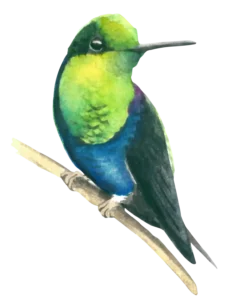
Empress Brillant (Brillante Emperatriz)
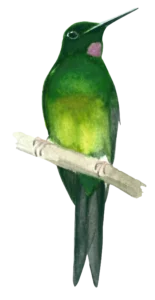
The Empress Brillant (Heliodoxa imperatrix) of the family Trochilidae inhabits the Andean cloud forest in northwestern Ecuador and western Colombia, and this impressive hummingbird’s thick bill and long tail, with a golden sheen on the belly, are among its features. The male has a purple throat patch, which makes it different from the others and can reach 15 to 17 cm in length.
These birds prefer humid forests full of epiphytes to feed and visit some feeders. It is important to note that it is an endangered species.
Violet Tailed Sylph (Silfo Colivioleta)
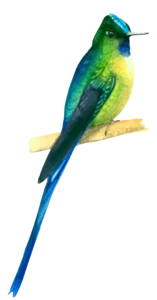
The Violet Tailed Sylph (Aglaiocercus coelestis) is a Trochilidae family bird in Colombia and Ecuador. They live between the eastern slopes of the Andes and the Pacific, in the lower level of the rainforest interior or forest edges.
The male has a bright green plumage with violet hues on the throat. It has a bluish rump and a metallic violet tail with bright blue tips, making it attractive. The average size is 18 cm. It feeds on flower nectar or forages at low altitudes. It is uncommon foraging for flowers in trees.
Brown Inca (Inca Pardo)
The Brown Inca (Coeligena wilsoni) is a species of bird of the Trochilidae family that inhabits Ecuador and Colombia. It lives in a humid cloud forest with dense thickets on the edges of the forest.
Its long, straight bill is one of the characteristics of this bird. The plumage is dark brown on the upperparts but brighter on the underparts, with the rump bathed in green, the belly with an iridescent purple guttural patch, and a white patch on each side of the breast. The bronze tail is slightly forked and measures 10 to 11 cm.
Nectar from grasses and epiphytes in the interior, forest edges, and tubular flowers in the understory are its food sources. It hunts insects and spiders from foliage and occasionally catches them.
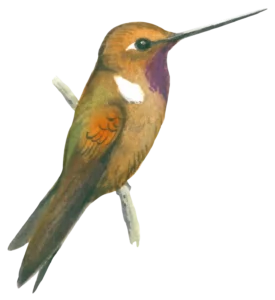
Velvet Purple Coronet (Coronita aterciopelada)
The Velvet Purple Coronet (Boissonneaua jardini) is a Trochilidae family bird in Ecuador and Colombia. It inhabits humid forests, forest edges, and clearings with shrubs on gentle slopes or declines.
This species has a black head, a black neck, a part of the mantle, and some parts of the chest and belly velvety, and the forehead, throat, and almost all of the bellies are iridescent purple; you can recognize it by this feature. Above, an iridescent greenish iridescent turquoise, with inner wing coverts and a reddish wing curvature. Except for the edges and a pair of dark central feathers, the square tail is almost entirely white.
The bird can reach 10 to 11 cm long with a short, straight bill of 2 cm. It usually feeds on insect, nectar and tubular corolla flowers.
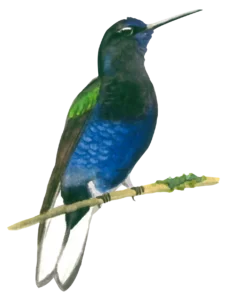
The Hummingbirds: A Living Legacy of Nature
Colorful hummingbirds are undoubtedly one of nature’s most captivating wonders. With their iridescent plumage and extraordinary aerial skills, these tiny fliers remind us of the beauty and grace that still linger in our world. Experience the thrill of observing hummingbird species in their natural habitat, dancing from flower to flower with unparalleled grace.
We invite you to discover why these little flyers have captivated explorers, naturalists, and nature lovers for centuries. Mashpi awaits you with wings spread, ready to enchant you with her everlasting magic.
